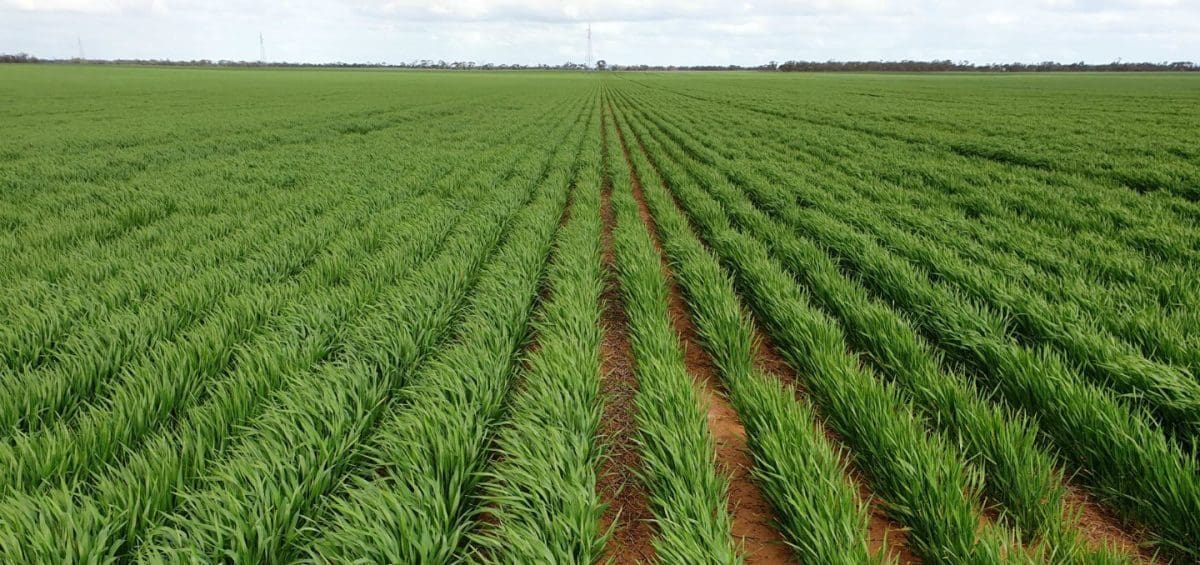
A crop of Spartacus barley growing near Swan Hill. Photo: Matt Witney, Dodgshun Medlin
SOUTHERN markets for wheat and barley firmed this week on renewed competition from container packers, while northern markets were mostly steady, despite some sell-side pressure.
A squeeze in the Sydney market tied to rail outages has now abated with the reopening of the Hunter and second Main South line.
Waterlogging remains an issue for some winter crops in southern Queensland and New South Wales, both of which had a mostly dry week which has enabled top-dressing and weed spraying to take place where paddocks are dry enough to allow field work.
Most of Western Australia’s growing areas had a welcome 15-30 millimetres of rain in the past week, and parts of Victoria and South Australia had a handy 5-10mm.
| Today | July 14 | |
| Barley Downs | $390 | $390 |
| SFW wheat Downs | $410 | $410 |
| Sorghum Downs | $345 | $345 |
| Barley Melbourne | $390 | $388 |
| ASW wheat Melbourne | $440 | $425 |
| SFW wheat Melbourne | $425 | $414 |
Table 1: Indicated delivered prices in Australian dollars per tonne.
North holds
Increased selling from growers and traders has met subdued demand from consumers who can see plenty of new-crop wheat and barley shaping up, and are being offered SFW wheat as owners look to quit stocks before the winter-crop harvest.
“Growers have waited for the new financial year and they are shocked at where the market is now compared to where it was in May,” one trader said.
In the first week in May, barley and SFW wheat markets delivered Downs and Melbourne were trading at $502-$505/t.
Barley in the northern market has had the biggest tumble, and is now trading at $390/t.
“I think there’s more barley planted than normal in the north because it got too wet for a lot of people to keep planting wheat.”
However, some growers in central and northern NSW are this week finishing their wheat-planting programs around four to six weeks beyond the close of the ideal window.
“They want to get something in the ground and they’re not planting chickpeas.”
Consumers in the north are buying modest amounts to fill in coverage ahead of the new crop, with harvest expected to start in the second half of October in southern Queensland.
“New crop is less $20-$30 on where the market is now, and with all this rain around, there’s going to be plenty of grain, so what’s still around will have to come to market by October-November.”
Consumers have started to book some new-crop tonnage, and most are filling in small amounts on their coverage out to October now.
“We’re just backfilling ahead of new crop.”
Bulk handlers are continuing to offer some tonnage originally destined for export out of up-country storages as growers and traders look to minimise old-crop carry-out into new-crop months.
Supply tightens in south
Container markets for ASW and higher grades of wheat are shaping up as large parcels of unpriced grain get harder to find in south-eastern Australia.
This is providing some competition to stockfeed millers seeking non-SFW wheat now that prompt demand has tailed off for bulk wheat in the closing months of the marketing year.
Melaluka Trading director Mick Fitzgerald said the high input prices of this year’s crop means growers are chasing yield by feeding the crop.
“The crop was put in with a substantial cost of production when urea was up around $1500-$1600/t, so they’ll keep chasing yield in order to cover that cost,” Mr Fitzgerald said.
Feed barley continues to find bulk demand from export, and from domestic consumers including dairy feedmills with clients keen to maximise production in the strong market for milk.
Some crops in Victoria, south-west NSW and South Australia are looking for a drink to bolster yield potential.
A run of frosts in some parts of south-eastern Australia has slowed growth, and negated the benefit of any recent showers.
“Some of these crops are pretty thick crops, and they’ll need rain soon because there’s been an enormous amount of urea spread on some of them.”
Rex James Stockfeed grain buyer Tim Hogarth said ASW has maintained its levels in the up-country market, despite an uptick in grower selling ahead of new crop.
“Grower selling nearly evaporated in April-May while the crop was going in the ground, but some is coming out now that it’s the new financial year and people are trying to empty storages,” Mr Hogarth said.
BAR1 feed barley is still being drawn into the Port Adelaide zone from Victoria, and Victorian feedmills are sourcing considerable tonnage from north of the border.
“I don’t think there’ll be a lot of carryout of barley in Victoria.”
With the second Sydney-Melbourne rail path now reopened at Gunning, consumers in the greater Sydney area are getting more grain arriving by train to ease the squeeze last week which lifted its values by around $30/t.
Grain Central: Get our free news straight to your inbox – Click here

HAVE YOUR SAY